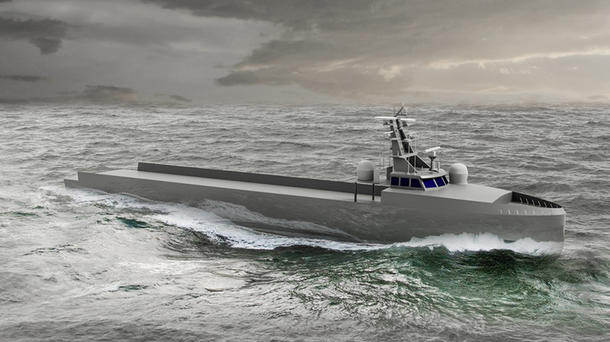
ARLINGTON, Va. — The most challenging aspect of designing large unmanned surface vessels for the Navy is building reliability of its systems, a senior defense industry official said.
“We can solve the autonomy challenge,” said Kevin Knowles, senior manager of strategic growth and USV team lead for Northrop Grumman Mission Systems, in a Dec. 14 interview with Seapower, discussing the company’s participation in the concept designs for the Navy’s Large USV and Medium USV. “How do we improve reliability, to put a ship to sea without a crew.”
Knowles noted an Arleigh Burke-class guided missile destroyer has a crew of about 300, with a third of those devoted to keeping the ship running. Without a crew preforming the routine preventative maintenance and repairs, reliability of systems in a USV becomes even more paramount, he said. Even when optionally manned, most of the personnel on board would oversee force protection.
The Navy is planning on adding to its fleet the LUSV and MUSV. The LUSV essentially will be a missile shooter, with banks of vertical launch systems. The smaller MUSV is intended for a reconnaissance and surveillance role, with an array of sensors, many of them in containers that can be switched out.
Northrop Grumman is teamed with two of the design teams awarded concept design contracts for the LUSV. Not a shipbuilder, its contributions would be most notable in mission systems and payloads. The team lead primes are Austal USA, Huntington Ingalls, Lockheed Martin, Fincantieri, Bollinger and Gibbs & Cox.
Knowles said a second challenge is the deliberate pace at which the Navy is proceeding with the programs, keeping the defense industry pressed to keep up. He noted some in Congress think the Navy is moving too fast, encouraging it to prove the technology before production.
He said the Navy will use a land-based test site at the Naval Surface Warfare Center Philadelphia Division to integrate and test the propulsion and other systems planned for the LUSV.
Developments in aviation also are being factored in as solutions to design challenges. Knowles said components of systems developed for the F-35 Lightning II strike fighter can be adapted to the USVs, offering the advantages of light weight and low energy usage.
The LUSV and MUSV likely will emerge with a common control system, he said, possible with many aspects of the Common Control System in work for the Navy’s unmanned aerial systems.
Another challenge for LUSVs and MUSVs is repair at sea. Such concepts as fly-away teams dispatched to the vessel could be considered.
Knowles praised the Navy’s program office, PMS-406, for keeping the prime contractors informed with the latest data and requirements needed for their designs.
- SECNAV: Frigate Delay Due to ‘Atrocious’ Shipyard Worker Retention - May 16, 2024
- SAIC Advances Scalable Open-Architecture Counter-UAS Systems - May 9, 2024
- Navy’s Triton UAV to Provide Targeting for LRASM - May 2, 2024



